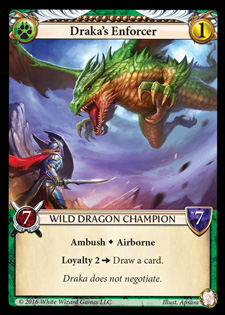Epic is a card game that was made by pioneers of the competitive and professional Magic community. It utilizes a single resource that is gained by both players every turn, without investment into the deck itself. Most of the game revolves around this resource, and maximizing the timing, and overall usage of it. This resource, called gold, is needed in order to play many of the cards in your deck.
Your deck must contain at least 60 cards, and cards only have two costs: zero or one. For every zero-cost card in your deck, you must have two one-cost cards in your deck as well. In almost every situation, you’ll wind up with 20 zero-cost cards, and 40 one-cost cards. Furthermore, your cards are divided into one of four factions, Good, Evil, Sage, and Wild. To put it simply: If you want to play two one-cost good cards in your deck, you must have a zero-cost good card to go with it. Faction alignments have very distinct characteristics, and are pivotal in choosing what exactly how you want to build your deck.
Now that you got the basic crash course, imagine having to wrap your head around that, while also learning the metagame and intricacies of Epic, in less than a week!
With the help of Thomas Dixon, widely considered one of the best Epic players in the game, I went to a proverbial boot camp. I haven’t done the whole travel, hotel, and tournament grind in a long time, but I couldn’t pass up the opportunity to potentially win $25,000.
The first thing I needed to do was pick a deck to learn, which Dixon and I quickly decided on. The Wild/Sage deck I settled on was about as close to a creature-based burn deck as you could possibly get, with a sprinkling of tempo thrown in. Think U/R Delver in Legacy. The deck wasn’t exactly the simplest deck, but it was something that fit right into my wheelhouse, and had, on text, the most powerful and punishing cards in the game. Situational was not what this deck wanted. Everything hit hard, was evasive, and replaced itself.

I was pretty set with my deck selection from the get-go, but now I had to understand all of the other hundreds of cards in the game, in multiple formats. The most difficult days of boot camping were spent trying to practice cube draft without eight people present to participate. Due to this restriction we had no choice but to practice constructed and dark draft.
The dark draft format is a heads up limited format using the entire Epic card pool. Ten packs of five are created, and the rest of the cards are unused. Both players pick up a pack, take one card, pass it to the other player, then takes two out of the remaining four cards. The final two cards are removed from the draft. This is repeated until all ten packs are drafted. Each player will play what they drafted, in what should be a 30-card deck.

Dark draft took up the most of our practice sessions as this was the best way of learning all of the cards, interactions, as well as it taking the middle three of the tournament rounds (with cube draft being the first two rounds and constructed being the last two). One of the first things I learned early on was that information is very important. Both players will know what the other has access to after they take their first card, so this can be used to heavily sway your opponent’s decision trees. If you have the choice of a ton of burn, or a ton of sweepers, whichever you decide to do will influence what your opponent will go for. Sweepers are also very strong, as the board state goes from zero to sixty beginning on turn one. Evasion is always great, and evasion combined with Ambush (Flash in MTG), is even better. A ton of sweepers are in Evil and Good, and evasion is normally found all around the alignments except for Sage, which has quite a bit of bouncing.
This newfound knowledge would give me a huge edge when it came to learning everything I needed to know.
Now it was time to apply it to the tournament…
To be continued!
Anthony has been competing in games for the better part of his adult life and is dedicated to improving his game, improving his community, improving himself as a person, and most importantly having fun and enjoying himself while doing so. You can check out his stream to find out which video game is the latest to catch his attention.

